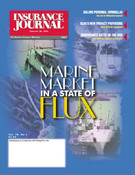The long-awaited hardening of reinsurance rates may finally be occurring, as companies reassess their capacity commitments and take a more critical look at their risk exposures, particularly concerning natural catastrophes.
“Where there’s loss activity, you’ll certainly see rate raises,” said Paul Walther, head of Reinsurance Directions Inc. in Heathrow, Fla. “It’s no longer a case of taking anything that’s out there-terms and conditions have hardened.” He sees rates rising between 10 and 40 percent as reinsurers reexamine their capital commitments and pay closer attention to the business they accept.
Swiss Re, one of the world’s biggest reinsurers, has already seen results from its policy of cutting losses by reexamining risks. “The entire reinsurance portfolio benefited from the improved conditions and higher prices,” the company reported recently. “Swiss Re successfully negotiated significant improvements in reinsurance conditions and prices for the January 1, 2001, non-life reinsurance renewal period. This renewal includes most of its business in the largest non-life markets: Europe, North America and parts of Asia.”
The operating assumption is to earn more by writing less. “Business relationships not in line with the profit requirements were either re-underwritten, cut back or terminated. In addition, Swiss Re has reduced its capacity (committed capital) for natural catastrophes by 10 percent with this renewal.”
In fact, the entire market seems to be affected. “Paralleling this welcome trend in its own reinsurance business, Swiss Re saw direct insurance rates and conditions improve in relevant large markets. Capital has been withdrawn from the reinsurance markets, and capacity in the retrocession markets is also dwindling,” the company reported.
Walther noted that rate increases, a more cautious approach to underwriting risks, and better management of capital are linked together, especially in large reinsurers and brokers. Ongoing losses, especially in the catastrophe and workers’ compensation sectors, have caused all insurers to reevaluate the nature and extent of the business they write. Securitizations and alternative risk transfers have given companies other venues for their capital commitments; therefore, what remains commands a higher price.
“Bigger companies also have greater resources,” Walther said. “This means that they can support the type of research that’s required to analyze risks. An underwriter’s responsibility is to ask the right questions, not necessarily to conduct independent research. For one thing, they don’t have the resources; for another, they’re anxious to write the business.”
He cited Renaissance Re, which just reported an 18-percent increase in net operating income in 2000, as an example. “Even though they’re not diversified, they select cat risks carefully. They get the best models from EQECAT or AIR, and extract as much value as they can from them. Then they construct their own even more sophisticated model, so they have a real understanding of the risks they accept.”
James N. Stanard, Ren Re’s CEO, would certainly agree. “Significantly, the 40-percent growth in managed cat premium solidifies our position as one of the world’s largest underwriters of treaty cat excess business,” Stanard commented on the earnings report.
“A successful January renewal season provides us with a very attractive portfolio of catastrophe reinsurance in 2001, leading us to expect another year of excellent performance.” He tempered his forecast, however, with the caveat that this assumed “normal loss activity.”
Reinsurers have realized that it’s easier to make money if they can retain a greater percentage of premiums, and have therefore concluded that losing market share by giving up riskier business is worth it, if it reduces claims. Walther agreed, commenting: “The idea that any exposure has its price may have to be modified.”
The upbeat earnings reports coming from catastrophe reinsurers for 2000 are due in large measure to the fortunate absence of major losses. While earthquakes, floods and windstorms continued to occur, they caused less damage. Swiss Re’s upcoming Sigma report on last year’s catastrophes estimates that total insured losses were around $11 billion, compared with $31 billion in 1999.
Now the year 2000 is history, and Swiss Re doesn’t think the benign trend will continue. It points out that where and when earthquakes and major storms hit is purely random, but given the changes observed in the global climate it assumes that “the trend towards higher losses will continue uninterrupted.”
It remains to be seen how permanent the rate increases are going to be. Walther feels that “cutting back on exposures and reducing marginal programs” is generally for the better, but he doesn’t see too much of a shift. “Basically reinsurance hasn’t changed-the contracts are still the same; the process is still the same, even if it’s conducted over the Internet; and the mind set hasn’t changed.”
Taking the long view, Walther said: “The ebbs and flows of the reinsurance cycle are still with us; there’s still lots of capacity out there, but maybe better analysis will keep companies from writing bad risks in the first place.”
Topics Catastrophe Trends Profit Loss Pricing Trends Reinsurance
Was this article valuable?
Here are more articles you may enjoy.


 FM Global Rebrands As FM
FM Global Rebrands As FM  AIG Files Amended Suit Against Former Execs, Dellwood Insurance
AIG Files Amended Suit Against Former Execs, Dellwood Insurance  Wall Street Pushes Back After Activists Escalate Protests
Wall Street Pushes Back After Activists Escalate Protests  What Disruptions Have Been Reported After the Global Tech Outage?
What Disruptions Have Been Reported After the Global Tech Outage? 


